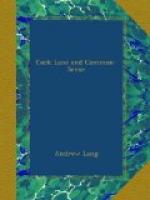The matter cannot have been so simple as that, but from the true solution of the problem we are as remote as ever. We can, indeed, study even the Cock Lane Ghost in the light of the Comparative, or Anthropological Method. We can ascertain that the occurrences which puzzled London in 1762, were puzzling heathen philosophers and Fathers of the Church 1400 years earlier. We can trace a chain of ‘Scratching Fannies’ through the ages, and among races in every grade of civilisation. And then the veil drops, or we run our heads against a blank wall in a dark alley. Chaldeans, Egyptians, Greeks, Eskimo, Red Men, Dyaks, Fellows of the Royal Society, Inquisitors, Saints, have perlustrated Cock Lane, and have come away nothing the wiser. Some, of course, have thought they had the secret, have recognised the work of God, ‘daemons,’ ‘spirits,’ ‘ghosts,’ ‘devils,’ ‘fairies’ and of ordinary impostors: others have made a push at a theory of disengaged nervous force, or animal magnetism. We prefer to leave theory alone, not even accepting with enthusiasm, the hypothesis of Dr. Johnson. ’He expressed great indignation at the imposture of the Cock Lane ghost, and related, with much satisfaction, how he had assisted in detecting the cheat, and had published an account of it in the newspapers. Upon this subject I incautiously offended him, by pressing him with too many questions,’ says Boswell,—questions which the good doctor was obviously unable to answer.
It is in January, 1762, that the London newspapers begin to be full of a popular mystery, the Cock Lane ghost. Reports, articles, letters, appeared, and the ghost made what is now called a ‘sensation’. Perhaps, the most clear, if the most prejudiced account, is that given in a pamphlet entitled The Mystery Revealed, published by Bristow, in St. Paul’s Churchyard (1762). Comparing this treatise (which Goldsmith is said to have written for three guineas) with the newspapers, The Gentleman’s Magazine and the Annual Register, we get a more or less distinct view of the subject. But the various newspapers repeat each other’s versions, with slight alterations; The Gentleman’s Magazine, and Annual Register, follow suit, the narratives are ‘synoptic,’ while Goldsmith’s tract, if it be Goldsmith’s, is obviously written in defence of the unlucky Mr. K., falsely accused of murder by the ghost.




